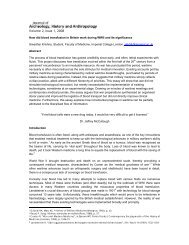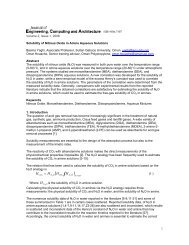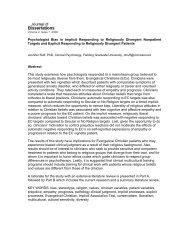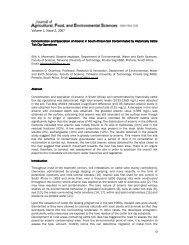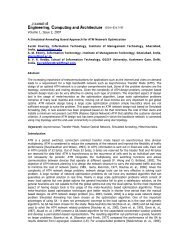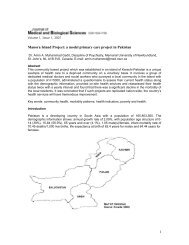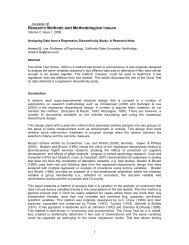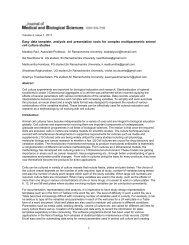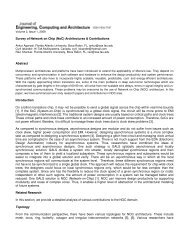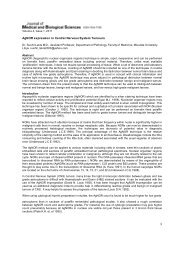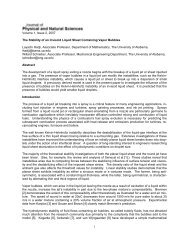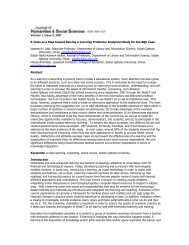The Heaven and Earth Society and the Red Turban Rebellion in ...
The Heaven and Earth Society and the Red Turban Rebellion in ...
The Heaven and Earth Society and the Red Turban Rebellion in ...
You also want an ePaper? Increase the reach of your titles
YUMPU automatically turns print PDFs into web optimized ePapers that Google loves.
pursuit of <strong>the</strong> rebels. 72 <strong>The</strong> <strong>Red</strong> <strong>Turban</strong>s periodically paused to attack towns, but without success. For <strong>the</strong><br />
most part, <strong>the</strong>y just tried to stay ahead of <strong>the</strong>ir pursuers. He Liu was killed <strong>in</strong> action on January 3, 1856 near<br />
Chenzhou <strong>and</strong> <strong>the</strong> rebel ranks th<strong>in</strong>ned steadily <strong>in</strong> combat. Kan Xian led remnants of <strong>the</strong> b<strong>and</strong> back to<br />
Guangdong by a roundabout route <strong>and</strong> was himself killed near Huaxian on September. 73<br />
In early 1856, Q<strong>in</strong>g forces had an easy time of it, <strong>and</strong> took <strong>the</strong>ir revenge on <strong>the</strong> helpless civilian<br />
population <strong>in</strong> <strong>the</strong> villages surround<strong>in</strong>g Guangzhou. Some claimed that a million people were killed <strong>in</strong> <strong>the</strong><br />
“White Terror” on suspicion of hav<strong>in</strong>g been connected to <strong>the</strong> ris<strong>in</strong>g. Ye M<strong>in</strong>gchen, <strong>the</strong> Governor-General,<br />
himself set <strong>the</strong> example for merciless repression by boast<strong>in</strong>g that he had been responsible for <strong>the</strong> deaths of<br />
100,000 rebels. 74<br />
4) <strong>The</strong> Nature of <strong>the</strong> <strong>Rebellion</strong><br />
<strong>The</strong> Composition of <strong>the</strong> <strong>Red</strong> <strong>Turban</strong> Rebels<br />
What social groups or classes <strong>the</strong>n dom<strong>in</strong>ated <strong>the</strong> <strong>Red</strong> <strong>Turban</strong> forces? It is difficult to be precise<br />
about <strong>the</strong> social composition of <strong>Red</strong> <strong>Turban</strong> followers. Sasaki Masaya dismisses <strong>the</strong>m as a group of<br />
vagrants, monks, sorcerers, <strong>and</strong> artisans. 75 On <strong>the</strong> o<strong>the</strong>r h<strong>and</strong>, Maeda Katsutaro states that rebel groups<br />
assembled several tens of thous<strong>and</strong>s of poor people, presumably peasants to oppose <strong>the</strong> tax abuse. 76 <strong>The</strong><br />
leadership of <strong>the</strong> <strong>Red</strong> <strong>Turban</strong> rebel groups is certa<strong>in</strong>ly of critical importance <strong>in</strong> any assessment of its<br />
character. Among <strong>the</strong> rebel leaderships, <strong>the</strong>re were fortune-tellers, bean-cake sellers, carpenters, sailors,<br />
actors, barbers, blacksmiths, rice pounders, m<strong>in</strong>ers, medic<strong>in</strong>e men, merchants who dealt <strong>in</strong> illegal trade<br />
such as smuggled salt <strong>and</strong> opium, hired laborers, robbers, pirates, pawnshop owners, <strong>and</strong> members of <strong>the</strong><br />
lower <strong>in</strong>tellectual class such as clerks <strong>and</strong> graduates of public exam<strong>in</strong>ations; to <strong>the</strong>se many more might be<br />
added, such as petty officers of <strong>the</strong> courts, military deserters, runners, peddlers, <strong>and</strong> smugglers. All <strong>the</strong>se<br />
groups were not dist<strong>in</strong>ctly separated, but overlapped each o<strong>the</strong>r. 77<br />
<strong>The</strong>re is little doubt that <strong>the</strong> majority of <strong>Red</strong> <strong>Turban</strong> outfits were led by members of <strong>the</strong> local secret<br />
societies. Equally <strong>in</strong>disputable is <strong>the</strong> fact that poor <strong>and</strong> lower constituted <strong>the</strong> majority of rank <strong>and</strong> file <strong>Red</strong><br />
<strong>Turban</strong> members. 78 <strong>The</strong>y came to be known as ‘<strong>the</strong> drift<strong>in</strong>g population (youm<strong>in</strong> 游 民 )”. In brief, members of<br />
72 “Q<strong>in</strong>g Wenzong Xianfeng Shilu 清 文 宗 咸 丰 实 录 ,” <strong>in</strong> Hongb<strong>in</strong>g Qiyi, 1152-53.<br />
73 “Yahu Caoshi zupu 雅 湖 曹 氏 族 谱 ,”Cao Fengzhen 曹 凤 贞 ed., <strong>in</strong> Hongb<strong>in</strong>g Qiyi, 851.<br />
74 Accord<strong>in</strong>g to Yong Kweng’s account, Sohak Dongjumki, 75,000 people were executed by Ye’s order <strong>in</strong><br />
Guangzhou only <strong>and</strong> more than half of <strong>the</strong>se people were not directly related to <strong>the</strong> <strong>Red</strong> <strong>Turban</strong> rebellions.<br />
See, Yong Kweng 容 閎 , Sohak dongjumki 西 學 東 漸 記 , Kwon, Heechul. tran. (Seoul: Ulyumoonhwasa,<br />
1974 ), pp. 63-65. See also G. W. Cooke, Ch<strong>in</strong>a: be<strong>in</strong>g ‘<strong>The</strong> Times’ special correspondence from Ch<strong>in</strong>a <strong>in</strong><br />
<strong>the</strong> years 1857-8, with corrections <strong>and</strong> additions, (London, 1858), 407; Wakeman, “Secret Societies,” 246.<br />
75 Sasaki Masaya, “Kampo yonen Kanton Tenchikai no haran 咸 豊 四 年 廣 東 天 地 會 の 反 亂 ,” <strong>in</strong> K<strong>in</strong>dai<br />
Chugoku Kenkyu Senta iho 近 代 中 國 硏 究 センタ 彙 報 , 2.3 (1963).<br />
76 Maeda Katsutaro 前 田 勝 泰 郞 , “Sh<strong>in</strong>dai no Kanton ni okeru nom<strong>in</strong> toso no kiban 淸 代 廣 東 における<br />
農 民 斗 争 の 基 盤 ,” <strong>in</strong> Toyo gekuho 東 洋 學 報 , 51 (March 1969), 1-38.<br />
77 Chesneaux justified <strong>the</strong>se people semi-proletarian <strong>in</strong>tellectuals or impoverished semi-proletarian vagrants<br />
who had fled from <strong>the</strong>ir home villages. For <strong>in</strong>stance, a pr<strong>in</strong>cipal <strong>Red</strong> <strong>Turban</strong> leader, Li Wenmao, was a<br />
wonder<strong>in</strong>g actor, <strong>and</strong> many o<strong>the</strong>r <strong>Red</strong> <strong>Turban</strong> leaders were semi-proletarian vagrants. Some of <strong>the</strong>se<br />
vagrants were drawn to <strong>the</strong> search for a new political authority because of many setbacks that <strong>the</strong>y had<br />
encountered after leav<strong>in</strong>g <strong>the</strong>ir native places; o<strong>the</strong>rs embraced a political vision because <strong>the</strong>ir social or<br />
occupational positions allowed <strong>the</strong>m to see <strong>the</strong> degenerate reality of <strong>the</strong> rul<strong>in</strong>g state. <strong>The</strong>se people <strong>in</strong>habited<br />
a world very different from that of <strong>the</strong> peasants <strong>in</strong>volved <strong>in</strong> local rent <strong>and</strong> tax resistance, for even <strong>the</strong><br />
poorest tenant was tied to his l<strong>and</strong> <strong>and</strong> even <strong>the</strong> propertyless cultivator clung to <strong>the</strong> plot he rented <strong>in</strong> order<br />
to go on liv<strong>in</strong>g. <strong>The</strong> objective conditions that brought <strong>the</strong>m to <strong>the</strong> leadership of political rebellions were<br />
supplied by <strong>the</strong> great mass of desperate marg<strong>in</strong>alized vagrants who were appear<strong>in</strong>g <strong>in</strong> greater numbers <strong>in</strong><br />
n<strong>in</strong>eteenth century. See Ibid; Lu, Liang’guang de Ti<strong>and</strong>ihui, 133-142; Jean Chesneaux, Secret Societies <strong>in</strong><br />
Ch<strong>in</strong>a <strong>in</strong> <strong>the</strong> N<strong>in</strong>eteenth <strong>and</strong> Twentieth Century (Ann Arbor: University of Michigan Press, 1971); See also<br />
Table 1, Occupation of <strong>the</strong> major <strong>Red</strong> <strong>Turban</strong> leaders <strong>in</strong> Guangdong, 1854-1855.<br />
78 Wang Tianjiang’s study reveals that <strong>the</strong> bulk of secret societies <strong>in</strong> <strong>the</strong> n<strong>in</strong>eteenth century was composed<br />
of six ma<strong>in</strong> types of social person; dispossessed peasants, artisans, small traders, small owner-mangers of<br />
various l<strong>and</strong> <strong>and</strong> water transport vehicles, laborers or porters, <strong>and</strong> disb<strong>and</strong>ed soldiers of <strong>the</strong> Taip<strong>in</strong>g <strong>and</strong><br />
12



